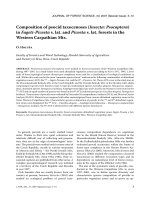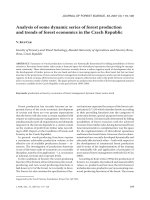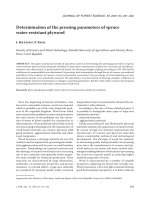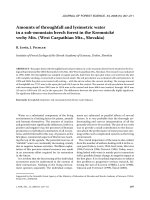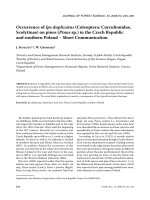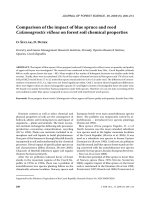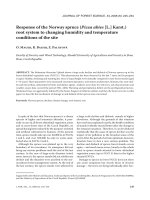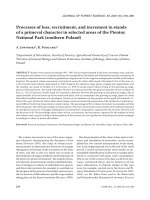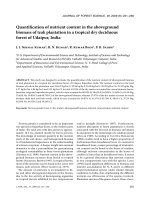Báo cáo lâm nghiệp: "Perception of the forest by the villagers of the Salonga National Park in the Democratic Republic of Congo" doc
Bạn đang xem bản rút gọn của tài liệu. Xem và tải ngay bản đầy đủ của tài liệu tại đây (471.43 KB, 6 trang )
J. FOR. SCI., 55, 2009 (7): 339–344 339
JOURNAL OF FOREST SCIENCE, 55, 2009 (7): 339–344
The Salonga National Park (1°00'–3°20'S, 20°–
22°30'E) covers approximately 36,000 km
2
and is
located in an isolated area of the Congo basin. It
is the second largest tropical rainforest reserve in
the world. The Salonga National Park (hereafter
referred to as SNP) is the habitat of many endemic
endangered species. e most prominent animal
species are:
– the dwarf chimpanzee (
Pan paniscus), locally
called Bonobo,
– the Congo peacock
(Afropavo congensis), which
are endemic to the Democratic Republic of Congo
(O 1986) and listed as endangered species
in the International Union for Conservation of
Nature (IUCN) Red Data Book (B, G-
1996).
e SNP is divided into two parts, separated by
an unprotected space of 50 km. ere are nine vil-
lages within the park. In the northern part: Kinki
Botonganji; in the southern part: Iyamba, Luapa,
Ila, Nsese, Ediki, Bosanja, Isambo Botongola and
Bokumu Beke (I 2008).
e native people, practicing slash-and-burn ag-
riculture, fishing, hunting etc., were settled in the
area before the creation of the park in 1970 and they
refused to leave. e government tolerated their
presence. Subsequently local people were hired as
labourers, and they enjoyed the limited non-com-
mercial right of use. Later, efforts were made to re-
orient management towards participatory multiple
use and co-management. It became clear that forest-
ers and villagers did not share the same perception
of the forest and its management (I 2009). e
forest is now threatened due to the presence of the
villages within the park (W et al. 1992).
There is little scientific information about the
forest or the utilization of forest products collected
by the local people (H 2002). e University of
Maryland (UMD) produced global land cover clas-
sification with 14 categories (H et al. 2000).
In the map of Tropical REsources and Environment
monitoring by Satellite (TREES), only these classes
were detected: lowland moist forest and secondary
forest mosaic (A et al. 2001). L’s et al.
SHORT COMMUNICATION
Perception of the forest by the villagers of the Salonga
National Park in the Democratic Republic of Congo
J. M. I
Faculty of Forestry and Wood Technology, Mendel University of Agriculture and Forestry in Brno,
Brno, Czech Republic
ABSTRACT: Effective forest management demands detailed knowledge of resources. Local forest users are usually
the best source of information. In the Democratic Republic of Congo forest management partnerships between local
people and government staff have become more common. A proper understanding of local perceptions of the forest
is needed. is study was designed and guided by a multidisciplinary team including a sociologist, a linguist and a
forester. It identified and compared classification and management units. It also touched on the different uses of the
forest products, the species that provided these products and the locations of these species.
Keywords: perception of forest; forest products; local villagers; Salonga National Park
340 J. FOR. SCI., 55, 2009 (7): 339–344
(1967) forest inventory covered an extended area in-
cluding the SNP. H (2005) studied the Salonga
forest using remote sensing.
Within the scope of my Ph.D. thesis I carried out a
socio-economic study in the SNP. My aim was to get
a better understanding of the local customs. Propos-
als to the government for a sustainable management
of the park would follow, inviting the active partici-
pation of the local people into the process.
is paper puts a particular emphasis on how the
local forest users perceive wooded areas. It focuses
on identifying and comparing classification and
management units. It also touches on the different
products/uses of the forest, the species that pro-
vided these products/uses and their location. It was
designed and conducted on the ground by a multi-
disciplinary team including a sociologist, a linguist
and a forester. e overall goal of this study was to
find ways of improving the management of forests
through a better integration of the villagers. Specific
objectives included:
– identifying the descriptors used by local villagers
for non-agricultural lands;
– explaining the classification units;
– describing the vegetation and use of each unit;
– describing the management of each unit;
– comparing the local classification with the “mo-
dern” classification;
– working out recommendations for forest manage
-
ment.
METHODS
e study tools included a survey conducted by
interviewers using a series of questions and a three-
day village workshop exchange session. Interviewers
who had experience with socio-economic studies
conducted the surveys. All interviewers spoke Lin-
gala, a local language. Twenty villagers were inter-
viewed in each village. For the investigation of tree
species, the approach was to identify use categories
at first and then to query villagers about which spe-
cies were used in each category. P (1981)
defined the following categories in Table 1. In Fig. 1
see map of the Salonga Park.
e approach of working from category to species
was more appropriate for the needs of the study.
Showing a villager a sample of the tree species and
Table 1. Categories of forest products
No. Wood products
1 Fuelwood
2 Construction wood (mainly poles)
3 Saw timber
4 Artisanal wood (utensils, etc.)
Products for livestock
5 Forage
Other products
6 Animal products
7 Beverages
8 Dyes
9 Fibres
10 Gums and resins
11 Honey and wax
12 Oils
13 Chemical products (tannins, poisons, etc.)
14 Pharmaceutical products
15 Food
16 Recreation/toys
17 Religious/sacred uses products
Table 2. Total number of tree species mentioned in this
study by use/product category
Use/product category
Pharmaceutical products 67
Beverages 53
Fuelwood 50
Wood 33
Fibres 30
Construction wood 30
Browse 27
Animal products 27
Honey and beeswax 25
Religious & traditional rites and ceremonies 24
Dyes 21
Entertainment/recreation/toys 19
Gums and resins 19
Chemical products 19
Saw timber 17
Artisanal wood 12
Oils 6
Total 110
J. FOR. SCI., 55, 2009 (7): 339–344 341
asking for uses encouraged the invention of uses.
While talking about uses, this approach also gave
the interviewers the opportunity to ask where these
species were found in the forest; to get an idea of
“use stands”. A use stand was considered as a unit
of the forest where there was one predominant use.
Typical questions were: Are there fuelwood stands,
medicinal stands, dye stands, tree fruit stands and
melliferous stands? And, if so, how do they exploit
these stands? What are the characteristics of these
stands and how are they managed? e responses
were compiled and compared. Data was presented
to representatives from all the four villages during a
three-day information exchange held in the village
of Mpoko (Fig. 2).
RESULTS AND DISCUSSION
Socio-linguistic aspects
e interviews revealed that the forest is viewed
as a disorganized and unstructured space. One in-
Fig. 1. Map of the Salonga National Park
Fig. 2. Forest dwellers in the Salonga National Park
342 J. FOR. SCI., 55, 2009 (7): 339–344
terviewee said the real name of the woodland was
“Ngonda” and “zamba” in Lingombe and Lingala
languages, respectively. These words are used to
describe a jumble of things. The idea of “dis-
organization” contributes to the perception of the
forest as frightening. When asked to describe what
the woodland contained one interviewee said “evil
spirits” (milimo mabe) that inhabit forests and
attempt to frighten those who venture there. To
villagers the forest is a world of disorder before hu-
man intervention. There are unusual happenings.
“You walk in the forest. When you get to a certain
place your hair stands on end and you shiver. You
see nothing but you are afraid.” “You suddenly get
hot for no reason.” The forest is perceived as a
habitat for evil spirits.
It becomes structured, organized and safe only
when transformed by humans. erefore it is con-
tradictory to talk about a classification system, which
implies a certain kind of structure. However, the
analysis of words used in Lingombe and Lingala lan-
guages to describe the forest reveals a rich lexicon of
more than 30 words. is lexicon has two character-
istics. First, it is mainly composed of words relating
to agriculture, which do not describe the forest cover
but soil and topography and second, those referring
to the forest cover. Hence they do not describe a
vegetative formation. ere were no similarities be-
tween the two classification systems used.
Forestry aspects
Harvest and use of forest products
is study underlined the villagers’ knowledge of
tree species. e harvest covers a range of products
from the Salonga National Park. e most commonly
used are fruits, leaves and wild shoots. e villagers
have provided a list of the 40 most heavily harvested
tree fruit species. is includes 37 species for mel-
liferous species (harvest of honey), 40 species used in
traditional medicine and 37 species for firewood. e
villagers use both traditional and modern medicines,
though they find traditional treatment the most ef-
ficient. ey believe that traditional medicine has a
sacred character, conferring a certain social prestige
and power. rough incantations, prayers and bless-
ings, traditional medicine is connected to animistic
religion.
Firewood is the main source of energy for the vil-
lagers, who have no access to electricity, and this
leads to the destruction of an extensive amount of
forest. e use of forest resources should have limits
because their misuse can cause serious consequences
leading to forest degradation.
For many product categories the number
of species is quite large
Table 1 summarizes the species in each category
as cited by local villagers. e number of species
per category seems high. Only for oils is the class
size less than 10% of the total. Two-thirds of the
total numbers of species are used as pharmaceutical
products. is fraction might have been much higher
had respondents not been limited to five species.
Confirming the list of pharmaceutical species, the
local traditional healers stated that all have a use in
traditional healing, although some individuals might
not know the specific use for a particular species.
Perhaps one-half of the species available are used to
make potions; nearly one-third provides food, fibres
or building poles. One-quarter provides forage, bee
products and enters into religious ceremonies or has
religious significance.
ere is no worthless tree species. erefore, from
a villager’s perspective all tree species have a use.
Nearly half the species are multipurpose. Nearly
50 species were cited in more than one category. Six
species are mentioned in over ten categories (Table 2).
Some tree species are multipurpose species.
Some species are considered multipurpose by for-
esters, such as Vittelaria paradoxa (mentioned in
13 categories) and
Parkia biglobosa (9). e list of
the top ten multipurpose species (by number of
uses) includes some species that are usually viewed
by the forester as being largely wood or timber spe-
cies. ese are Pterocarpus erinaceus (12), Isober-
linia doka (11), Afzelia africana (10) and Daniellia
oliveri (9).
e survey revealed significant differences in the
way men and women perceive the forest. e men’s
perception and classification of forest are focused on
spatial units, agricultural potential and soil type. is
is logical given that men are culturally responsible
for providing the primary needs of the family. e
women’s perception was based more on products
and with individual species as the classification unit.
It included different marks for different species, and
various marks depicting various forest products.
is is because women have limited access to agri-
cultural land, and think less in terms of agricultural
potential than forest products.
However, the attempt to relate species to vegeta-
tion types brought vague responses. e manage-
ment of forest resources by villagers seems to be
based on the species as the management unit. Lo-
cal knowledge is oriented to smaller units in line
with the daily activities of the villages. A villager
understands only partially the larger perspectives.
Fuelwood as a “management objective” is reflected
J. FOR. SCI., 55, 2009 (7): 339–344 343
in the species choice and not in the choice of vegeta-
tive formation. e villagers consider probably that
forest management based on the type of vegetation
is less diversified than a differentiated management
system for each tree species.
It is difficult to compare the two forest classifica-
tion systems – there is no easy translation from one
to the other. Each seems to have its own concept.
One system seems to reflect an empirical and sub-
sistence dynamic, the other a theoretical and “eco-
nomics of scale” dynamic. e extent to which the
villagers undertake activities in the forest to use the
species composition and encourage the regeneration
of preferred species is unclear.
CONCLUSIONS
e forester and the local forest user do not agree
regarding forest management units. e forester
uses management units providing efficient manage-
ment based on the production of a limited number
of products, the units being defined spatially. In
contrast, the local users have opted for the species
as the management unit. Species providing the same
types of product are disseminated throughout the
forest and are not classifiable.
In the case of fuelwood, it seems clear that although
37 species were cited, there is a limited number of
preferred fuelwood species just as there is of fruit
species – not all species are used for fuelwood. e
traditional search for fuelwood is for wood species
disseminated throughout the forest landscape; it does
not appear to be the harvesting of fuelwood areas.
Management of these forests with the main objective
of maintaining the production of all non-wood for-
est products currently utilized by local users means
managing species by species. For the forester this
requires an amazing level of detailed knowledge of all
the species, their uses and their biology and sustain-
able harvesting techniques. e villagers’ perception
of the forest goes against the conventional wisdom
that their view is in harmony with nature. Although
dependent on the forest, the villagers consider that
it carries a threat. It appears disorganized to them,
even though species are well known and much used.
e forest becomes useful only as it is changed into a
humanized space. For the villagers, the forest obeys
some kind of supernatural law; which perhaps only
a few initiates, such as hunters, can understand; con-
servation is not a priority. e pressure to transform
the forest, despite the many products and services
that it provides, is intense.
Villagers and foresters classify the forest differ-
ently. e proper integration of villagers into forest
management requires a synthesis of these two per-
ceptions. is may be achieved through the better
integration of the forest into local rural production
systems together with the promotion of positive
cognitive appropriation of the forest through activi-
ties which “humanize and socialize the forest” while
conserving it.
R ef er en ce s
ACHARD F., EVA H., MAYAUX P., 2001. Tropical forest map-
ping from coarse spatial resolution satellite data: production
and accuracy assessment issues. International Journal of
Remote Sensing, 22: 2741–2762.
BAILLIE J., GROOBRIDGE B., 1996. IUCN Red List of reat-
ened Animals. IUCN Gland: 378.
HANSEN M.C., DeFRIES R.S., TOWNSHEND J.R.G.,
SOHLBERG R., 2000. Global land cover classification at
1km spatial resolution using a classification tree approach.
International Journal of Remote Sensing, 21: 1331–1364.
HART T., 2002. Conservation in Anarchy: Key conditions
for Successful Conservation of Okapi Faunal Reserve. In:
TERBORGGH J., SCHAIK V.C., DAVENPORT L. (eds),
Making Parks Work, Strategies for Preserving Tropical
Nature. Island Press: 76–85.
HUANG S., 2005. Multisource data combination for the as-
sessment of Salonga National Park in the importance of
multi-sensor satellite data applications for environmental
monitoring with special emphasis on land cover mapping,
desertification monitoring and fire detection. Munich,
Ludwig-Maximilians-Universität München: 24–37.
IBESOA J.M., 2008. Proposal of a sustainable management of
the Salonga National Park in the Democratic Republic of
Congo. [Ph.D. esis.] Brno, MUAF: 127.
IBESOA J.M., 2009. Use of the forest products by the native
people of the Salonga National Park, in the D.R. Congo.
Brno, Acta Universitatis Agriculturae et Silviculturae,
LVII: 51–60.
LEBACQ L., DESCHAMPS R., LIBEN L., BRUNFAUT R.,
KATONDI J., 1967. Contribution à un inventaire de forêts
du Nord-Kasaï. In: Annales. Série 8, Sciences Economiques
– Musée Royal de l’Afrique Centrale, No. 5, Tervuren: 497.
OATES J.F., 1986. Action Plan for African Primate: 1986–1990.
IUCN/SSC Primate Specialist Group. New York, Stony
Brook.
POULSEN G., 1981. e Function of Trees in Small Farmer
Production Systems. FAO/SIDA Forestry for Local Com-
munity Development Programme. FAO, Rome.
WILKIE D.S., SIDLE J.G., BOUNDZANGA G.C., 1992.
Mechanized logging, market hunting and bank loan in
Congo. Conservation Biology, 6: 570–580.
Received for publication September 16, 2008
Accepted after corrections February 20, 2009
344 J. FOR. SCI., 55, 2009 (7): 339–344
Vnímání lesa domorodým obyvatelstvem v Národním parku Salonga
v Demokratické republice Kongo
ABSTRAKT: Efektivní lesní hospodaření je založené jak na detailní znalosti lesa a zdrojů, které les zahrnuje, tak na
účasti místních lidí, kteří jsou často o problematice lépe informováni. V Demokratické republice Kongo se zvyšuje
úsilí o vytváření partnerství mezi místními obyvateli a lesními úřady pro obhospodařování lesa. K vývoji trvale
udržitelného lesního hospodaření je žádoucí integrovat lokální komunity a dát jim prostředky k činnosti. Rovněž
je důležité pochopit a osvojit si představy, které místní obyvatelé o lese mají, a které mají i o způsobu hodnocení
lesem poskytovaných užitků.
Klíčová slova: vnímání lesa; lesní produkty; domorodé obyvatelstvo; Národní park Salonga
Corresponding author:
J M I, Ph.D., Mendelova zemědělská a lesnická univerzita v Brně, Lesnická a dřevařská fakulta,
Lesnická 37, 613 00 Brno, Česká republika
tel.: + 420 545 134 052, fax: + 420 545 211 422, e-mail:
